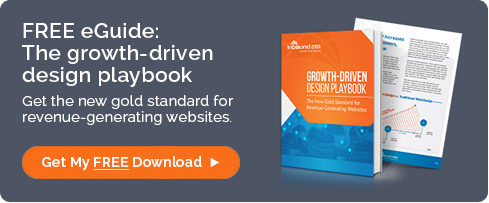Stellar Inbound Web Design Tips For Innovative Marketing Supremacy
First impressions are everything. They set the tone for how your customer relationship will (or won’t) unfold. Nowhere is this principle more true...
2 min read
Mark Parent
January 28, 2018 1:03:00 PM EST

Inbound 281's blog often refers to inbound marketing as a type of marketing with many moving parts.
Your website is, of necessity, one of the foundational pieces of your inbound marketing strategy. With growth-driven design (GDD), your website becomes supercharged as a marketing tool.
How so?
 GDD helps you identify what performs best with your target audience, and this information
GDD helps you identify what performs best with your target audience, and this information
enables you to create content to support your best assets. ![]()
Inbound marketing is all about delivering engaging content, creating an ideal user experience, generating leads, and cultivating those leads all the way through their buyer journey and the entire customer lifecycle.
Growth-driven design helps you to do all of those things more efficiently, driving revenue growth for your business.
One of the cardinal rules of content creation as a part of inbound strategy is that your content must be consistently relevant and engaging to your target audience. To that end, you create buyer personas to help you visualize that audience.
In CMI's "10 Ways to Make Your Website Content More Relevant (and Rank Higher)", Neil Patel has this to say:
"Relevance is completely audience-dependent. Part of the reason why relevance seems mysterious is because it is often viewed as a static entity - something that you can attain or achieve. In reality, relevance is a dynamic force. It is born in the identity of the user and responded to in the content of the marketer."
What does all this have to do with growth-driven design? GDD enables you to modify content on your website, update downloads and offers, and add new pages with fresh content, as needed.
Additionally, because GDD is data-driven, you can quickly see how each content asset is working on your site, and make adjustments to your strategy accordingly. GDD helps you identify what performs best with your target audience, and this information enables you to create content to support your best assets.
In a similar way, GDD helps you make adjustments in the design elements of your campaigns to ensure that each element increases conversions.
With GDD, you can easily test changes to design elements, placement, and CTAs. Using heat mapping technology, you can quickly see how your visitors are interacting with your site and make adjustments as needed.
Ideally, your social media accounts all lead visitors back to your website so that your customers can share your content and interact with your brand.
GDD allows you to optimize the placement of your social icons and sharing buttons to better appeal to your target audience. This is, of course, in addition to the content creation advantages mentioned earlier.
GDD also yields valuable information about which social media sites your visitors are using, thereby helping you target your inbound marketing campaigns more accurately.

GDD can help bring the pieces of your marketing puzzle together. ![]()
Because it allows you to track every action item you implement, the growth-driven design process enables you to make future inbound marketing decisions based, not on mere supposition, but on customized, comprehensible data.
A variety of metrics can be captured and analyzed to aid this process, including:
Each of these metrics represents a piece of a larger inbound marketing puzzle. Embracing GDD as integral to your overall inbound strategy will drive growth for your business. To talk with inbound marketing specialists who create growth-driven web designs regularly, please contact us today.


First impressions are everything. They set the tone for how your customer relationship will (or won’t) unfold. Nowhere is this principle more true...

Many business owners think of website design in terms of aesthetics. It's true that the ideal design should be visually appealing, but your business...

Think about the last time you visited a theme park, such as SeaWorld or Disneyland. How would you rate the experience? Maybe you're thinking about...